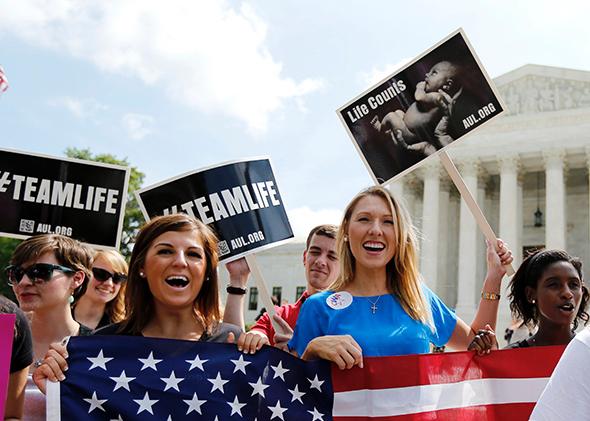This morning, the Supreme Court handed down two unanimous decisions (I am inventing the word faux-nanimous effective immediately to account for Scalia’s very dissent-y concurrences) in two of the most hotly contested cases of the term. The first is Canning, the recess appointments case. In the second, the court held that Massachusetts’ 2007 abortion clinic buffer zone law, which requires that abortion opponents stay 35 feet away from clinic entrances, violates the First Amendment. Writing for the whole court, Chief Justice John Roberts says that the law, which makes it a crime to knowingly stand on a “public way or sidewalk” within 35 feet of an entrance or driveway to any “reproductive health care facility,” is unconstitutional.
The Massachusetts law was passed after two clinic workers were shot and killed by a gunman at abortion clinics in Brookline in 1994. The challengers in McCullen want to approach women seeking abortions, and said the buffer zone thwarted their ability to offer face-to-face counseling. The federal appeals court found the zone to be a reasonable “time, place, and manner” regulation. Today, the high court reversed that decision. From now on it looks like these buffer zones outside clinics are presumptively unconstitutional. There are similar regulations at clinics in Portland, Maine; Pittsburgh; California; and elsewhere. They are modeled on the buffer zones that were approved in the high court’s decision in a 2000 case, Colorado v Hill. That case was not overruled today.
While the decision is not monumentally awful in ways some progressives most feared, and certainly affords the state substantial latitude in its future attempts to protect women seeking abortions from harassment, more than anything it seems to reflect a continued pattern of “free speech for me but not for thee” or, at least, “free speech for people who think like me,” that pervades recent First Amendment decisions at the court. More importantly, I don’t know where to locate this ruling in the burgeoning doctrine of “the right to be let alone” that Justices Alito and Thomas and Breyer have espoused, nor do I know how to reconcile it with the court’s persistent second-rate treatment of any speech that threatens to harass the justices themselves.
Right now, the commentary is pretty predictably split between those who believe that the rights of “peaceful sidewalk counselors” were vindicated, and those who believe those counselors are actually pro-life bullies. The court opts for the gentle counseling characterization, without acknowledging that it was the extreme conduct of the latter group that led to passage of the law, and that, realistically, in the absence of the buffer zone, both types of protesters will be greatly emboldened. I guess from here on in, you won’t know whether you are being intimidated or “gently counseled” until after it’s happened.
While the court is almost obsessively concerned with less restrictive methods of preventing clinic visitors from being harassed, it’s less solicitous of Massachusetts’ claims that those methods were insufficient. And while the court is silent about the constitutionality of the “free speech pens” around political conventions, and buffer zones around circuses, churches, and funeral services, presumably they are still permissible. Because those sorts of gentle counselors are different. I am searching for a reason that buffer zones are reasonable at polling places and the Democratic convention, but not for women seeking intimate medical care. Help me Obi-Wans.
In a gorgeously un-self-aware way, the same Supreme Court that severely limits speech and protest in a buffer zone all around its own building, extolls the unique and wonderful properties of the American boulevard in today’s opinion: “With respect to other means of communication, an individual confronted with an uncomfortable message can always turn the page, change the channel, or leave the Web site. Not so on public streets and sidewalks. There, a listener often encounters speech he might otherwise tune out. In light of the First Amendment’s purpose ‘to preserve an uninhibited marketplace of ideas.’ ” This from jurists who pride themselves on turning the page, changing the channel, and leaving the website, and generally declining to consume news or television that challenges their worldview.
The court did not accept the protesters’ arguments that the buffer law targets particular forms of speech because it only targets clinics that perform abortions, and because it exempts clinic employees, thus favoring their viewpoints. Still, it found that the regulation was impermissible because it thwarts important public dialogue on “public way[s]” and “sidewalk[s],” places historically used as sites of discussion and debate. And there is a deeply disturbing concern for the declining “success rates” of the sidewalk counselors, who can’t persuade enough people to change their minds. I can’t recall from the opinion in Snyder v. Phelps, the Westboro Baptist Church case, great judicial concern that the members of the Phelps family weren’t succeeding in converting enough military families into homophobes.
This is, as the ACLU keeps telling us, a really hard case. There are real speech interests at issue here and real interests in public safety. This Massachusetts law clearly targets abortion protesters in a way that the buffer zone in Colorado, which the Supreme Court upheld, does not. (Colorado’s law established buffer zones outside all health care facilities, not just abortion clinics.) But it is exhausting to keep hearing from the pro-life movement that women seeking abortions are magical pixie princesses, who must be—thank you Justice Kennedy—babied and soothed and gently counseled for the brief moments in which they contemplate abortion. As though these “difficult conversations” are really only for their own benefit. Unlike mourners, or voters, or Supreme Court justices, they simply need to be told what to do. That’s why this case is harder than a simple “yay, speech wins” reaction can capture: Privileging “gentle counseling” for some isn’t quite the same as promoting free speech for all.
